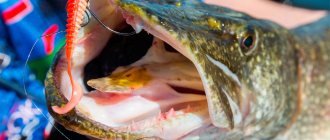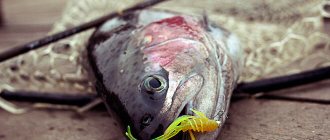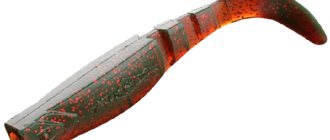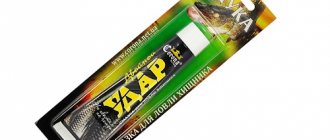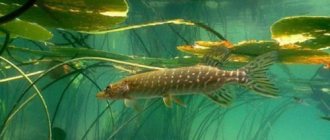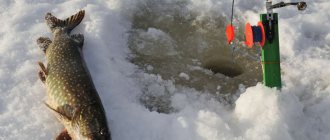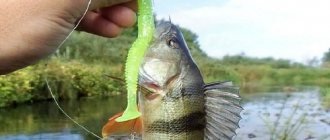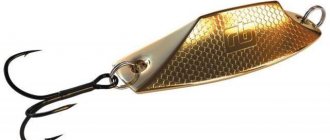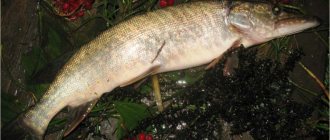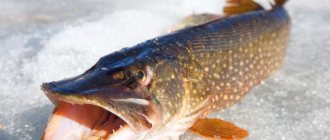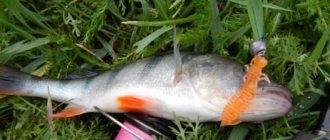Yuri 11/26/2020 198
What to do when it doesn’t bite and how to deal with it? This question would not be so relevant if we were talking about catching minnows or small perch, on a quiet evening on the river bank, just for fun. But how to solve the problem if the fishing was planned in advance and the object of the hunt is such a serious rival as pike?
Quite often you can hear the opinion from people who are far from fishing that the pike is stupid and unceremoniously grabs any bait. And if the toothy beast doesn’t bite, then it’s not in this place at all. This statement is dangerous because it becomes a dogma for many beginning spinning players. As a result of this, an inexperienced fisherman does not even try to find out the reason for the lack of bites. As a result, the baggage of experience is not replenished, the quality of fishing becomes worse.
Today we will talk about why a shortage of predator bites does not mean its absence in a particular place, as well as what tactics to choose for catching passive pike.
We invite you to look at our photos where fishermen show off the pike they caught at the Sazanya Bukhta fishing base.
Edible silicone baits
Recently, edible silicone baits have become very popular. They have become the No. 1 bait for me and my spinning friends. And this despite the high cost. Against the background of edible silicone, other silicone baits remain behind the scenes. But you shouldn't lose sight of them. There are often times when the same perch actively feeds and stays in large schools. In this case, silicone, which is stronger than edible, will come to the rescue. But I will tell you, based on my own experience, when the fish is inactive, it is much more difficult to “stir” it without using edible bait. The point, in my opinion, is not even in the edible silicone itself, but in its softness, smell and correctly selected size. The attractant and salt are part of the silicone itself. It also means a lot that edible silicone baits are mainly made for inactive models (worms, slugs, crustaceans, octopuses, etc.), but they can provoke even the most inactive fish to bite. And not only predatory. Using edible silicone baits you can purposefully catch peaceful fish: crucian carp, rudd, etc. But surprises also happen when catching a predator. On one of the last pike fishing trips, carp pecked at edible silicone. There were a lot of bites, and there were gatherings. But we still managed to catch two carp. In the photo there are carps of 4.2 kg and 2.8 kg.
Today, when the market is flooded with a wide range of edible silicone baits, it is difficult not to get confused and buy something worthwhile. Unfortunately, not all edible baits catch fish well. What are the criteria for determining high-quality and catchable edible silicone? First of all, these are reviews from comrades who have tried this or that edible bait. But if there are no such people among your friends, then I will give some advice.
So, the first and most important thing when choosing an edible silicone bait is the presence of an attractant and salt in the silicone itself. Many manufacturers impregnate ready-made silicone bait with various attractants and sprinkle with salt. I call such baits conditionally edible, since both the salt and the attractant are quickly washed off and the silicone must then be lubricated with the attractant. In real edible baits, the attractant and salt are initially added to the silicone itself. Therefore, they never lose their smell and taste.
The second, no less important, criterion is the presence of glitter in the silicone bait. This component significantly increases the number of bites.
Well, the third criterion is the similarity in size, shape and color of the intended hunting object - pike, perch, etc.. These are all kinds of imitations of fry, crustaceans, worms, etc.
Pike loves smooth, leisurely movements with a sweeping play of the bait, which hovers above the bottom, slowly moving its tail and creating micro-oscillations. Such vibrations simply have a magical effect on the hunting instinct of the pike and provoke it to attack. All this is true if you take a twister or vibrotail. Basically, edible silicone, which is really catchy (especially “worms”, “crustaceans”, slugs, etc.), does not have its own game. Therefore, animation of the bait is necessary, created using a spinning rod and various types of postings. For this you need a corresponding spinning kit, but more on that later.
Size and color of silicone bait
Speaking about the choice of silicone bait for pike fishing, I will be based on personal experience that I was lucky enough to acquire at competitions and consolidate in practice on private fishing trips, as well as when observing athletes who purposefully catch pike. In principle, for pike the main component is the bait itself. Therefore, a silicone bait should be chosen so that it is as resistant as possible to breaks on aquatic vegetation, stones, and shells. In terms of size, I prefer silicone lures 2-2.5 inches long if the pike are inactive, and larger lures (no more than 10 cm) for active pike in late fall.
This year I was faced with a situation that was completely incomprehensible to me. And if I hadn’t tried it myself, I would never have believed it. It turns out that even in murky water, pike and other predators like dark colors and transparent silicone. Moreover, inclusions of glitter in silicone of any color dramatically increase the catchability of the bait. Of course, poisonous colors (light green, burning crimson, etc.) also attract pike, but dark colors (brown, caramel, machine oil, dark purple and even black) attract pike much better precisely during the period of its passivity. And if it’s also an edible silicone bait...
So, we are on the pond. What to apply in specific conditions at this time of year? By specific conditions, I mean a body of water with or without current, its depth, the presence of vegetation on the bottom and surface, and much more. But you don’t need to take my advice as some kind of rule. In order to properly mount the tackle, you need to understand the entire upcoming fishing process and, based on this, think about choosing a silicone bait, its loading and wiring. So, let's take the minimum weight of the jig head as a basis. Well, let's say 2-3 grams. In this case, our bait is a “worm”, a slug, a “crustacean” or something similar, 2–2.5 inches (5–6.3 cm) long. With this set, you can comfortably fish at depths from 1 to 3–4 m, depending on the wind strength. It’s also worth adding that with a lighter jig head, there will be more bites.
Wiring a silicone bait when fishing for passive pike
Having decided on the bait (in our case it is a passive silicone bait), you need to choose the type of wiring. And again, remember and take into account the following: the pike stands in ambush so that it can see the future victim from above itself. Hence the priority of a light-weight jig head and, accordingly, the slowest retrieve. Sometimes dragging along the bottom wins, but a more acceptable retrieve is 5–10 cm from the bottom with smooth pulls and pauses of up to 3 seconds. Also, we should not forget that when fishing for pike you need to fish a promising place from several points. This will work if you are on a boat. If fishing is done from the shore, then try to fish the place at different angles to the shore. Make casts to the left, to the right, perpendicular to the shore.
When a silicone bait is equipped with a hinge with a “eared” sinker, the bait takes on a more lively appearance during the animation process, which, you see, cannot but affect the effectiveness of the fishing itself. And the wiring in this case looks like two or three smooth lifts of the tip of the spinning rod from 10 o’clock to 11.30 with reeling in the cord. At the same time, during pauses, it is necessary to give slack to the cord and pause after the bait touches the bottom for 2-3 seconds.
But the water cooled down even more (4–6 C), and the pike began to “be capricious.” Pike bites became rare or disappeared altogether. There are several explanations for this, as well as ways out of this situation. The fact is that as the water gets colder (November - December), the metabolism of pike and other fish slows down. She continues to feed, but not as actively as before, and this cannot be ignored. The pike will no longer chase after a quickly drawn bait, but will wait until the prey comes to it itself or passes by very slowly, with long stops. The wiring can be left the same, but the amplitudes should decrease. The bait should “jump” literally in one place and low (maximum 8–10 cm from the bottom), and the pauses should increase to 5–8 seconds. For pike, it is better to bait the bait with the same wave-like wiring, but with a smoother and slower amplitude. There are frequent cases of pike biting during a prolonged pause. Well, let's say you received a call, and while you are talking on the phone, the silicone bait lies motionless on the bottom. At this moment the pike bite occurs.
Pike fishing in open water
There are several ways to catch pike during the open water season. Pike can be caught with a spinning rod, with a float rod, with live bait, with a donka, with summer baits and with mugs.
Some of these methods require the presence of a boat, others can be carried out both from a boat and from the shore. Each angler chooses for himself the method that suits him best based on the conditions in which he has to fish, the availability of certain fishing gear, and his personal preferences in fishing.
Spinning
Pike fishing with a spinning rod is the youngest, and at the same time, the most popular way of catching this predatory fish. The principle of spinning fishing is to cast the bait using a rod and then retrieve it by rotating the reel and moving the rod.
Fishing for pike with a spinning rod involves constantly moving the angler around the reservoir to search for active pike, changing baits and constantly experimenting with a variety of fishing rods. You can catch pike with a spinning rod throughout the open water season, from early spring to late autumn, with the exception of the time of spawning ban. Fishing for pike with a spinning rod can be done both from the shore and from a boat, but as a rule, a boat greatly expands the angler’s capabilities.
For pike fishing, a spinning rod is used (covers for spinning rods here), equipped with a spinning reel (covers for reels here), on which a cord is wound, to which an artificial bait is attached through a leash. Pike fishing with spinning rods can be done both from the shore and from a boat. To catch pike from the shore, use a rod with a length of 2.7 m, and when fishing from a boat it is easier to use a shorter rod with a length of 2.1-2.4 meters.
The diameter of the fishing line (cord) is selected taking into account the expected size of the prey. For pike fishing, both braided lines and monofilaments are used.
When fishing for pike, you must use a leash, the function of which is to protect the fishing line from the sharp teeth of the pike. The leash is most often made of Kevlar, titanium, tungsten or guitar string. Some fishermen use fluorocarbon leashes when fishing for pike; they are almost completely invisible in the water, but are less resistant to pike teeth than metal leashes.
A wide variety of spinning lures are used to catch pike.
:
Oscillating spoons
- one of the oldest spinning baits. They are a metal plate curved in the longitudinal or transverse direction, in the tail part of which a tee is fixed. When moving in the water, the oscillating spoon moves from side to side, rolls from side to side or trembles slightly, creating vibrations of a certain amplitude and frequency that attract predatory fish. Oscillating spoons are used for catching pike both in still water and in the current. Oscillating spoons are quite versatile, easy to use and inexpensive, which is why they are very popular among anglers.
Spinners
easy to use and catchy, most beginning spinners begin their journey in spinning by fishing with spinners. Spinner baits consist of a wire rod on which is attached a metal petal and a treble hook. When the spoon moves in the water, during the retrieve, the petal rotates around the rod, creating high-frequency vibrations and glare in the water that attract predators. Rotating spoons have numbers that indicate the size of the blade of the spoon, spoons come in sizes from 00 to 6. For catching small and medium-sized pike, rotating spoons numbered 2 and 3 are well suited; for catching large pikes, spinners numbered 4 to 6 are used.
Silicone baits
are a very popular class of lures for pike fishing. The method of fishing with silicone baits is called jig. Silicone baits come in a wide variety of shapes and types, the most common among them: twisters, vibrotails, worms, octopuses, crustaceans, frogs. Many types of silicone baits resemble in their appearance real food items of predatory fish, others are completely fantasy. Silicone baits are divided into edible and inedible; attractants are added to edible baits, which additionally attract fish with their smell and taste. Silicone baits are available in a large number of different colors. For fishing, silicone baits are mounted on a jig head or on an offset hook connected to an eared sinker (Cheburashka). Lately, fishing with spaced-out rigs has become increasingly popular among spinning anglers: retractable leash, drop-shot, Carolina and Texas rigs.
Wobblers
are solid baits, their appearance resembling fry and intended for catching predatory fish. Wobblers can be of different sizes. To catch large pike, you can use wobblers with a length of 100 mm and above. For catching medium-sized pike, wobblers 7-10 cm long are suitable. Wobblers vary in shape, each of which has its own name: minnow, shad, crank, fat and others. Good results when fishing for pike are shown by minnow wobblers, which are carried out with a special jerking retrieve called twitching. Other types of wobblers show good results: shads, poppers, cranks.
Wobblers vary in the degree of buoyancy; they are: floating, suspended and sinking. Wobblers also vary in depth, they can be: surface, subsurface, shallow, deep, ultra-deep. Depending on the fishing conditions, the angler selects a wobbler that is suitable in terms of its parameters and characteristics.
When fishing for pike in shallow waters overgrown with underwater vegetation and in dense snags, good results can be obtained when fishing with a spinnerbait. The use of other types of bait leads to either the inability to catch at all, or to very frequent snags. A spinnerbait often comes to the rescue in such conditions. Its very design was created for successful fishing for predatory fish in difficult places, replete with underwater obstacles. The upper shoulder of the spinnerbait pushes aside obstacles, serving as a kind of bumper, the petals push apart obstacles that arise along the way, the rigidly fixed hook is protected from snags by the skirt.
Live bait fishing rod
Many anglers catch pike on a float rod with live bait attached to a hook. To catch pike with a fishing rod, anglers use a long telescopic rod, which allows them to cast into windows of clear water. An inertial or spinning reel is installed on the fishing rod; most anglers use a spinning reel, which is much easier to use.
A leash must be installed between the fishing line and the hook, which can be metal, Kevlar, titanium, tungsten, guitar string or fluorocarbon fishing line. Fluorocarbon leashes are less noticeable in the water, but less resistant to pike teeth than metal leashes.
The float must be special for fishing with live bait; it is barrel-shaped and has a large carrying capacity so that the live bait cannot drown it. The float must be loaded up to the antenna. You can buy a float at a fishing store or make it yourself from a champagne cork. The float should be visible at a distance of up to 20 meters. The hooks used are relatively small; they can be triple, double or single.
When choosing live bait, you should take into account the degree of its survivability; pike prefers live and active fish; it most often ignores dead ones. Good bait for live bait: small crucian carp, carp, gudgeon, roach. It is best to catch live bait in the same body of water where fishing will take place; pike are more willing to catch food that is familiar to it. If there are a lot of frogs in the body of water where you are fishing for pike, they are most likely a frequent prey for pike, so fishing for a frog will most likely be successful. Live bait must be released into the water.
Fishing for pike with a live bait rod is most effective in the summer on small rivers with gentle currents and heavily overgrown reservoirs with standing water. It is better to catch pike with a live bait rod from a boat in order to increase the number of places fished.
After casting live bait, the fisherman waits five to seven minutes; if during this time there is no bite, he should move to another place. The fisherman can periodically return and re-fish old fishing spots that have already been fished.
Bottom fishing rod (donka)
A bottom fishing rod is not the best tackle for catching pike. In summer, pike stay in thickets of underwater vegetation, in snags. In such places there is no opportunity to perform a normal cast and to land the caught pike on the bottom tackle.
Many anglers successfully catch pike using bottom tackle in water bodies that are clear of underwater vegetation and snags. At the same time, they use both a classic donk and a donk with a rubber shock absorber. The best time for such fishing is spring, when the underwater vegetation has not yet had time to grow, and late autumn, when the bulk of the underwater vegetation has already died off. You can cast bottom gear along the shallows where pike come out to feed. You can use live bait or a frog as bait. Pike of all sizes are caught with live bait, and, as a rule, the largest individuals are caught with frogs.
If you choose between a classic donka and bottom tackle with a rubber shock absorber, then you should give preference to rubber, which does not require the use of a boat for repeated casts and creates much less noise that scares away pikes.
Catching pike with summer baits
The supply rig is the oldest equipment for catching pikes. The zherlitsa has an extremely simple device. You can fish with a zherlitsa on a pond, lake or small river. Grills are installed in places where pike often hunt for small fish: in windows among aquatic vegetation, under trees overhanging the water, next to flooded bushes.
Zherlitsa consists of
:
- A reel, which can be made from a wooden flyer with splits at the ends, from a plank, plywood or even a plastic bottle.
- Fishing line of sufficient strength, wound on a reel, at least 7 meters long
- A lead sinker, which is needed to hold live bait so that it does not go into the grass
- Fluorocarbon leader tied to the fishing line via a swivel
- Hook, quite large in size, which can be triple, double or single
Live bait is attached to the hook of the girder and the tackle is thrown into the water.
The best live bait for catching pike in summer: bleak, dace, perch, roach, gudgeon. The fishing line is inserted into the split of the flyer in such a way that when the pike takes the bait, the fishing line is released from the split, and later, when the fishing line finishes unwinding, the pike will hook itself. The reel is tied to a tree and a pole driven on the shore or in the water. Anglers who fish with girders install several girders in the most promising places in the reservoir, and, as a rule, leave them overnight. In the morning, fishermen go around the girders one by one and check them.
Fishing with mugs
A circle is a floating version of a summer vent
. The circle is a foam float in the form of a disk, which has a groove for winding fishing line at the end. Different sides of the disk are painted in different colors, usually white and red. When a pike grabs a live bait, the circle turns over with its bright side up, alerting the angler to a bite.
There are two ways to catch pike with mugs. The first method is used on calm rivers and lakes; mugs with attached hooks are allowed to float freely. The mugs slowly float through the water, under the influence of the current and the force of the wind, and look for the pike themselves. The second method of fishing with circles is to secure the circles in one place using a fishing line with a sinker attached to it. In this case, the mugs are placed near snags, next to thickets of grass, that is, in those places where actively feeding pike often hang out.
Pike fishing with mugs is done from a boat. In order to catch the maximum area of the reservoir, the mugs are installed or floated in a checkerboard pattern. The mugs must be within the angler’s visibility at all times so that he can react to pike bites.
It is best to use live bait taken from the same reservoir where pike fishing will be carried out for baiting mugs. Live bait is placed at half-water or forty centimeters from the bottom. During the fishing process, the fishing horizon is changed, depending on which horizon the bites most often occur on.
The fisherman must constantly monitor the circles and as soon as one of them is triggered, he slowly and carefully, trying not to scare off the pike that took it, swims up to the triggered circle. The fisherman carefully collects the line into the boat, and as soon as he feels the heaviness, he makes a hook and begins to fish out the caught pike. Pike are caught in circles throughout the open water season, but the best time for this method of pike fishing is September-October, the time of the autumn pike feeding season.
Equipment
To complete the information, a few words should be said about important little things that help increase the number of bites from a “sleepy” and cautious predator. And the first thing I would like to mention is the use of a piece of fluorocarbon about 1 m long as a leash. The diameter should be selected based on the choice of the hunting object. If it's a bass, I would recommend a fluorocarbon diameter of 0.14-0.16mm with a main line of 0.06-0.08mm. Of course, when a pike bites, there is a risk of losing the bait. Shearing may occur. But you need to come to terms with this and initially get used to the fact that silicone baits are consumables. But you will win in the number of perch bites. But if pike is a frequent guest on your fishing trips, then there are two options. The first is to install the same fluorocarbon, but with a diameter of 0.25 mm or 0.3 mm. This will increase the chances of saving the bait with an almost constant number of perch bites. But their frequency will still decrease. The second method will 100% save the bait from pike teeth, but will significantly (by about 40%) reduce the number of perch bites. This is a “twist” leash made of string with a diameter of 0.17 mm. I tried to install such leashes about 5 cm long, but remember: no one canceled a piece of fluorocarbon. The tackle is mounted as follows. A piece of fluorocarbon is tied to the main cord, and a “twist” leash is attached to it. Next, having untwisted the “twist”, we attach the silicone bait mounted on the “eared” head and twist our “twist” back. All is ready!
Why is a piece of fluorocarbon necessary even when using a “twist” leader? The explanation is quite logical, because it was not for nothing that at the beginning of the article I wrote that we need to try to understand our actions. A fluorocarbon leader (if it is within 1-1.5 m) serves three functions. The first is invisibility in water, which means a decrease in the caution of the predator. The second is to smooth out the jerks of the fish when playing. After all, as you know, fish don’t break spinning rods and don’t tear tackle. But if this happens, it means that the tackle is incorrectly assembled and adjusted. It is the well-coordinated work of the spinning rod, clutch, cord and leash, as well as the ability to catch fish in cold blood, that will never lead to the spinning rod breaking down or the gear breaking.
Also, the stretchability of a fluorocarbon leash allows the same perch to suck in a silicone bait without feeling the resistance of an inextensible cord by moving its gills. Of course, fluorocarbon is not a fishing line, it is less stretchable, but it still stretches more than a line and is less noticeable in the water than a fishing line. And finally, the third thing is windage. Everyone knows that the slower the bait floats in the water column, the more tempting it is for the fish. As usual, a fluorocarbon leader is used with a smaller diameter than the main line. For these purposes, it is even advisable to use it when fishing with medium and heavy jigs using a cord with a diameter of, for example, 0.14–0.16 mm and a fluorocarbon leash about 1 m long and 0.3–0.5 mm in diameter. There is another advantage of fluorocarbon. It is resistant to various types of abrasives. I mean that it will save the bait from being cut off on edges with shell rock or on stones when fishing in such places.
In addition to fluorocarbon, the use of the same “eared” sinker, but made of tungsten, will help to camouflage the bait, or rather, hide the “eared” weight. This metal is heavier than lead, which means the load will be much (about 30%) less than lead of the same weight. In addition, treating a tungsten weight with a gray or black non-matte coating will make it virtually invisible altogether. It is enough to take lead and tungsten balls and look at them at eye level. You will see a lead ball as a circle, the diameter of which is equal to the diameter of the ball. Looking at a tungsten ball, you will only see a small dot. So the fish will see all this. In addition, when a tungsten ball hits the bottom (especially hard ones - stones, shells), it makes a ringing sound, which additionally attracts pike from long distances.
Habits from childhood
In the article about two forms of perch, an example was given of the division into active and passive individuals. The difference in the scale of movement, the size of the fish was shown, and the difference in nutrition was indicated. For perch, the easiest way would be to attribute the difference in growth rate and timidity to diet. They say that the predatory fish-eating perch receives more calories per unit of time than its relative, which eats invertebrates in the grass.
But correlation is not causation. If we look at other species of animals, where there is also such a division into bold and timid, it turns out that the type of food for many of them is absolutely the same. Moreover, some species cannot make much choice, since millions of years of evolution have left their mark even on nutrition.
A great example is cats. They have initially bold individuals (they can be identified almost immediately after birth) and initially cautious ones. But at the same time, different cat personalities do not differ in food preferences. And all because cats are strictly obligate predators. That is, those who support an exclusively meat diet. A cat can eat anything, but its body will function normally only on meat. So if, during a pasta diet, the cat actively shits in his owner’s shoes, this will be fair retribution for the wrong food.
It’s exactly the same with pike; it is also an exclusively meat predator. But most likely he won’t shit in his slippers. And the difference in nutrition among perches with different “characters” stems from facultative predation. In other words, bass don't need to eat only fish—worms and leeches will work, too. The only difference in the feeding habits of different pikes may be selectivity. For example, shy pike may be less enthusiastic about attacking large prey, preferring prey sizes that can be “sucked in” as quickly as possible. More details about this were in Shchuk’s article. Size hierarchy, cannibalism, food theft and other pranks.
However, already at an early age, pikes begin to discern differences in character. And around the end of the first year of life, we can quite confidently identify bold or cautious individuals. Moreover, this manifests itself not only in behavior. Some pike go to live in specific areas that differ significantly from what we call the lace kingdom.
The fate of such pikes will develop differently. First of all, a difference in height will become apparent at the very beginning. Those pike that go into open water begin to grow faster and generally gain good physical shape. For example, it is very beneficial for males of such pikes to be larger in their age group. Simply because they can subsequently perform reproductive functions better and at the same time risk less to their health.
However, this is a long term perspective. But apparently such delayed benefit greatly outweighs the risk of mortality. True, it is still unknown what exactly makes some pikes leave comfortable places. There is an assumption that this is the result of the displacement of such pikes from internal competition for resources within the “incubators”.
Sedentary and migratory pikes
Perhaps this is where the primary division of pikes into homebodies and travelers comes from. And some variety in the pattern and distance of migrations may also be the result of the very first “choice” - to go into open water or sit in the grass. Ultimately, two groups of pike emerge from one spawning: resident and migratory.
The sedentary ones remain in the spawning area (in the broad sense: small rivers, streams, floodplain lakes, bays, etc.) and live there all their lives, making up the indigenous population. There is an opinion that the majority of sedentary fish. Those fish that we meet in very small rivers in summer, autumn and early winter are just like that, sedentary. Moreover, sedentism is not always associated with the small size of fish.
Migratory fish only use spawning grounds, and after spawning they migrate back to larger bodies of water. However, some of these fish can remain in the spawning area in the summer, but still go into deep water for the winter. We often see such pikes on the same small rivers in spring and late winter. And it is precisely because of them that we can get to the so-called pre-spawning feast, when in a very small river there suddenly becomes a lot of pike, including quite a decent size. Decent relative to the river, of course.
From this we can draw two preliminary conclusions.
- The larger number of sedentary fish suggests that the general tendency among pikes is to be relatively inactive. And this is a good argument in support of the concept “pike is a typical ambush predator.”
- The presence of pikes with different physical activity among one generation explains the relatively rapid (3-5 years) restoration of rivers after defishing. Of course, subject to a number of reservations. However, the mechanism for maintaining and expanding the population and species as a whole should not be underestimated.
Home territory
The big picture
The understanding of the term “settlement”, the regular mention of the territoriality of pike and the many evidence of repeated catches of the same fish from the same point hint at the need to clearly indicate this territoriality. These are the boundaries of pike settled life. Ideally, we want to get a specific and unambiguous “from now to now” with a list of externally readable features. But in fact, there are no strictly defined borders, strict territoriality, or even more specific signs. There is something else, more complex and ambiguous.
For rivers, we can easily explain the blurring of the proposed territory by the variability of habitat conditions. The water rose, fell, the flow increased in winter or almost stopped in summer. In our understanding, these factors easily break the paradox of a territorial pike without its own territory. But for closed systems, especially lakes, we are more inclined to believe in the existence of strict and long-term points where there will be no pike only if it is removed.
In fact, in both water systems, the territories and, moreover, their boundaries are greatly blurred. The only difference is that in a river it is easier to identify potential point segments of such territories. And, apparently, it is on these point segments that we most often come across resident pike. Since it is known that pike, for one reason or another, quite actively use connections to the terrain and vegetation, it is not difficult to identify such points.
Interestingly, nomadic fish are likely to occupy limited territories if they are moved to non-residential areas of the river. However, such fish try to hold points only in those areas where there are not a large number of other migratory fish. And this is quite logical, because in rivers the division into populations (sedentary and migratory) is more likely due to the smaller amount of food and suitable areas than in the lake []. And although this is known from studies of trout, we should not forget that pike and trout are very close relatives. And the conditions in the river are basically the same for all predators.
Worth reading: Large pike in floodplain lakes: where to look and what to think about
Migratory fish are very likely to pass by us, using the “obvious” places only for a short time. And we call a meeting with one or several pikes on a bare fast riffle at the end of November (when migratory pikes go into deep water) or February (when pikes, on the contrary, rise to the spawning grounds) an accident. In principle, this is how it is. Our meeting with such pikes and in such circumstances most often occurs by chance due to strong stereotypes regarding the seasonal characteristics of pike fishing in small rivers. But the very presence of pike in such places still has some pattern.
However, some observations shed some light on the issue of home territories. However, I must warn you that the information presented below must be used with extreme caution, since it was collected on small samples and individual statements are on the border of statistical significance.
The only thing is that we can sometimes observe some relationship between the size of the fish and the size of its territory. That is, the larger the fish, the larger the territory under its control. It is likely that we are talking about pure physiology here: a larger body size allows you to swim better and further.
Field research results
Home range
The earliest observations were often based on theoretical concepts. For example, for a long time it was believed that pike are, in principle, prone to a sedentary lifestyle. Consequently, it occupies some point or area, and sits there almost all its life. True, how such a site is chosen, why such sites in reservoirs without a current are sometimes located far from spawning grounds, and how the pike gets there is kept silent.
But somewhat surprisingly, the relative sedentism was confirmed with the advent of radio beacons and echolocation. And quite significant confirmation was the work of the late 60s and early 70s done in the USSR on the Rybinsk Reservoir []. They indicated that pikes have a strictly limited territory with a size of 50-150 meters for a flat bottom, beyond which they practically do not go. But in the area with the old riverbed, such an area grew up to 500 meters.
These works are implied (even by those who do not know about them) when talking about the movements of pike. Because some people, who by virtue of their position are invited to fishing educational interviews, continue to rely precisely on the works indicated in the footnote, answering the question “how far does the pike walk.” But there were already problems with the research at the time of its conduct that did not allow us to consider the results obtained as general for all pikes. First of all, because of the amount of time that was spent on field observations - 50-60 hours. And in one of the works the observation period is not indicated at all. But even the marked 50-60 hours is too short. Why is that?
Because from some recent studies, often not related to migration, we know that the feeding and locomotor activity of pike are not interdependent. This means that an actively moving pike may not eat, and an actively feeding one may almost stand still. In our fishing life, we often come across something like this when we catch a pike, and it’s all hung with bunches of leeches. At the same time, pike could be very active in terms of feeding behavior. And she collected leeches on herself precisely because of standing in place, which happened the day before. And at different times everything turns out differently: today the pike is actively swimming, and tomorrow it stands still.
Thus, the research carried out could have been carried out precisely during such a period of time when the pike was inactive. In other words, it just happened, an accident. But fortunately, other observations were also carried out (hot on the heels or for a completely different reason) with a more qualitative approach to the methodology and using long periods of time. And here the picture turns out to be clearer.
One of the first relatively large-scale observations was made in Canada in 1977. The goal was to double-check the statement about home territories, and at the same time establish the difference between the winter and summer positions of pikes. The main conclusion: it is not possible to identify strictly limited areas. In fact, pikes occupy all the most favorable space for life.
Moreover, during the study process, which took 47 days, it turned out that all the observed pikes walked quite freely. Some of the fish covered distances of up to 4 kilometers during the day, and the average distance was slightly less than a kilometer per day. For pike there was no big difference between summer and winter routes. The only difference is that in winter the pike stayed, on average, a little further from the shore. Perhaps this was due to fairly thick (75 cm) ice, which could partially block access to some areas.
Interestingly, distance records were set mainly in winter. Although there is a suspicion that this is due to pre-spawning migration. Of course, the pike was not constantly in motion and had occasional periods of rest, but no details were provided on this matter.
Activity Center
After this and several other similar studies, it turned out that the term home range, originally applied to mammals, is very poorly suited for fish in general and pike in particular[]. Because fish, unlike mammals, demonstrate more temporary range boundaries. In addition, in some cases it was reported that pike change habitats annually. For example, during the spawning period or, as described in the previous chapter, daily. Therefore, the term home range was replaced by center of activity.
In general, this topic itself caused a lot of controversy. In particular, due to the nature of many experiments: the fish were marked and released in the place where they were caught. In this regard, some researchers have stated that all these areas with centers are just the result of random settlement. Well, those experiments where marked fish were released in a very different place were few in number.
An interesting experiment was in the small (25 ha) German lake Kleiner Döllnsee, which is closed to any type of fishing and is used only for research purposes.
Here it turned out that if you catch a pike at point A and release it at point B, after a very short time (4-143 hours) it will return back to point A. However, no connection was found between the duration of the return and the size of the fish. But accumulations of pikes and their retention of certain territories were noticed. It is interesting that the winter activity centers were larger than the summer ones, and the differences between the locations of these centers were not particularly noticeable. Of course, there were pikes that greatly changed their position in winter, but in general the same places were used.
The initial explanation for the larger size of the winter activity center was that it was due to spawning migration. However, this assumption was later discarded as untenable. Argument: progress was made in February, but spawning occurred only in April. But the version where the increase in the size of territories occurs due to the destruction of grass areas looks more plausible. That is, the grass dies off, food fish stop using it, and pike have nothing to do there either.
However, it remains unknown what exactly causes the pike to return to its starting point. There is a general hypothesis that an animal never acts for nothing and there are reasons for everything. Returning to the center of activity, sometimes across the entire lake, should carry with it such benefits that it will outweigh the risks during the journey. However, in that lake, pike was the dominant predator, and there were few very large fish (80 cm or more). Therefore, the risk in this case seems to be minimal.
But there is another version, according to which pikes leave a “dangerous” place if they see the so-called agonistic behavior of other pikes. In this case, it can be assumed that they will add a “marker” to their cognitive map that associates this location with danger.
As for the size of the center of activity, although we can sometimes trace some dependence on the size of the pike (larger fish ⇒ larger area), in general the size of the territory depends more on the size of the reservoir. Thus, for the lake from the study discussed, the area of the summer activity center was 1392.5 m² in summer and 3612.5 m² in winter.
These numbers are very small, but they can be even smaller or even larger. For example, in a lake with an area of 4.5 hectares (this is a puddle of approximately 100 * 450 meters), repeated captures of pike in most cases occurred within 100 meters from the release site [] . In fact, the pike hardly moved here.
Worth reading: How fish swim
For rivers the situation is somewhat different and there is no direct relationship between the size of the center of activity and the size of the river. Thus, in one of the studies (and not only this) it turned out that river pikes use very small areas, on average 157 m². And this figure agrees well with the previously described uneven distribution of resources in rivers and lakes.
Between rivers and lakes there are reservoirs, which in their structure and functioning are in the interval between one and the other type of reservoir. Surprisingly, pike in reservoirs also use an intermediate life option. In reservoirs, pike move less than in lakes. And the theoretical centers of activity in reservoirs are smaller than lake ones, but larger than river ones.
Thus, all studies conducted indicate the creation of limited centers of activity by pikes. However, it is not yet possible to make any generalization for different water systems.
